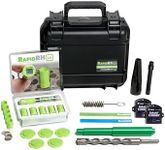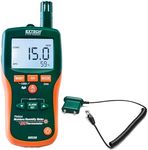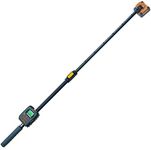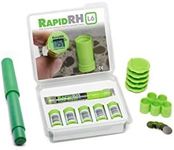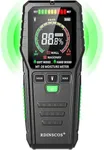Buying Guide for the Best Moisture Meters
Choosing the right moisture meter is all about understanding what you need to measure and how you plan to use the device. Moisture meters are used in a variety of fields, from woodworking and construction to gardening and home inspection. The right meter will help you get accurate readings, avoid damage, and make better decisions about your materials or environment. Before buying, think about the types of materials you'll be testing, how often you'll use the meter, and whether you need quick checks or detailed analysis.Type (Pin vs. Pinless)Moisture meters come in two main types: pin and pinless. Pin meters use two metal probes that you insert into the material to measure moisture, which can leave small holes but tends to be very accurate for deeper readings. Pinless meters use a sensor pad that you place on the surface, which is non-destructive and faster but may only measure surface moisture. If you need to avoid damaging the material, a pinless meter is better, but if you need to know what's happening inside, a pin meter is more suitable. Your choice depends on whether you prioritize accuracy at depth or preserving the material's surface.
Measurement RangeThe measurement range tells you the lowest and highest moisture levels the meter can detect, usually shown as a percentage. A wider range is useful if you work with different materials or need to detect both very dry and very wet conditions. For most woodworking or building tasks, a range from about 5% to 30% is common, while gardening or soil meters might have different ranges. Pick a meter with a range that matches the typical moisture levels of the materials you plan to test.
AccuracyAccuracy refers to how close the meter's readings are to the actual moisture content. Higher accuracy is important if you need precise measurements, such as in professional woodworking or building inspections. Accuracy is usually given as a percentage (like ±1%). If you just need a general idea of moisture, a less precise meter may be fine, but for critical work, look for a model with a low margin of error.
Material CompatibilitySome moisture meters are designed for specific materials, like wood, drywall, or concrete, while others can be adjusted for different types. It's important to choose a meter that works with the materials you plan to test. If you work with a variety of materials, look for a meter with selectable settings or scales for different substances. If you only need to test one type, a specialized meter may give more reliable results.
Depth of MeasurementDepth of measurement indicates how far into the material the meter can detect moisture. Pin meters can often measure deeper, depending on the length of the pins, while pinless meters usually measure just below the surface. If you need to know about moisture inside thick materials, choose a meter with deeper measurement capability. For surface checks or thin materials, a shallow depth is sufficient.
Display and ReadabilityThe display shows your moisture readings, and a clear, easy-to-read screen makes using the meter much simpler. Some meters have digital displays with backlighting, while others use analog scales. If you'll be working in dim areas or need to read results quickly, a bright, digital display is helpful. Choose a display style that matches your working conditions and personal preference.
Additional FeaturesSome moisture meters offer extra features like data hold (to freeze a reading), audible alerts, temperature measurement, or the ability to store readings. These can make your work easier or more efficient, especially if you need to keep records or work in challenging environments. Think about which features would actually help you, and avoid paying for extras you won't use.




